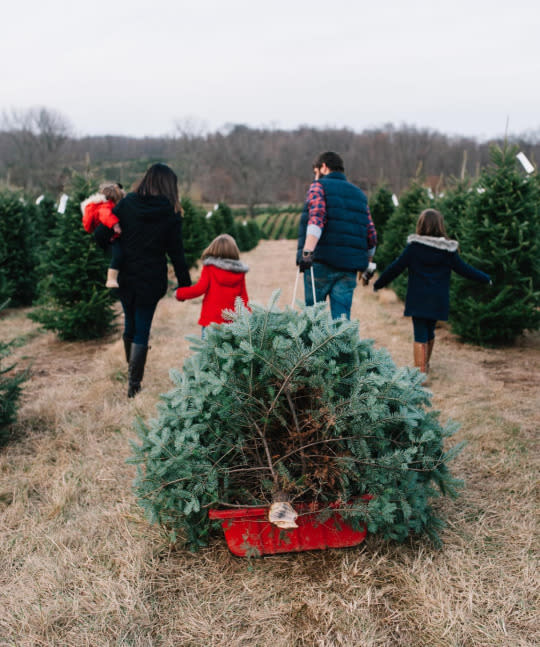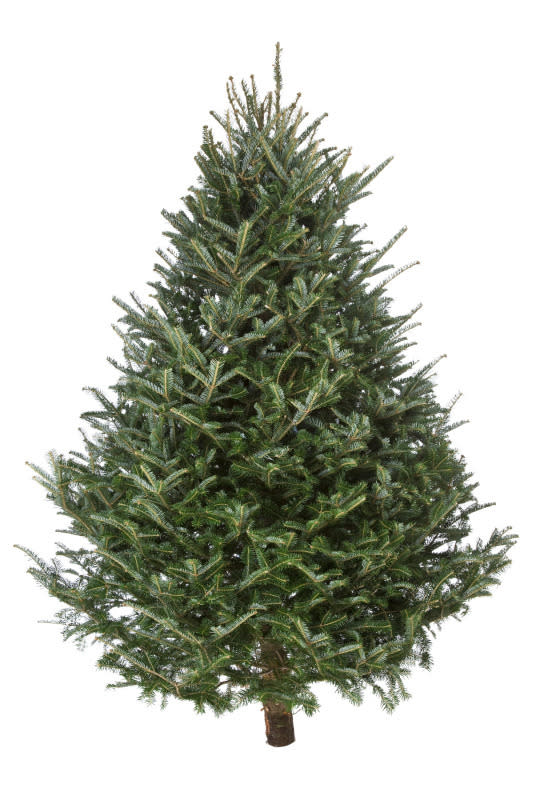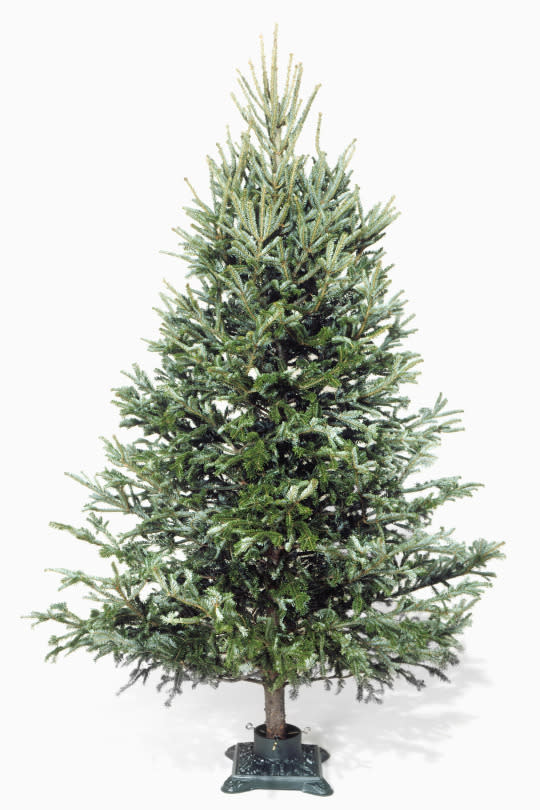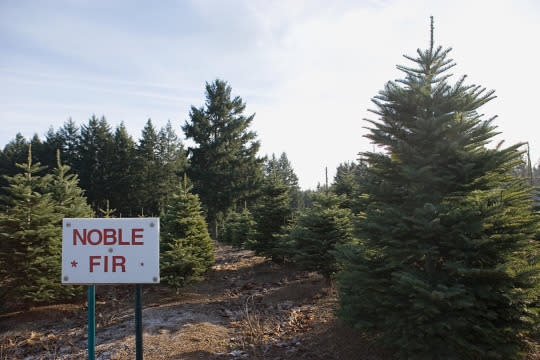The Christmas Tree That’s Perfect for Your Family

Christmas tree season is officially here. And whether you’re making a pilgrimage to a snow-dusted farm or heading to the local parking lot to pick out your living centerpiece, you’ll have several varieties to choose from. While aesthetic preferences often have the greatest impact on which tree we take home, there are a few other things to consider. Here’s how to pick the best Christmas tree for your family.
If you want your tree to last until January:
The key is choosing a species of tree with thicker needles, which play a part in its “keepability,” according to Lynn and Bob Schutte, owners of Northern Lights Christmas Tree Farm in Pleasant Hill, Ore. “If the tree has thicker needles, it’s going to last longer because it has a greater capacity to retain moisture,” Lynn tells Yahoo Parenting. The couple recommends choosing varieties like a noble fir or a Fraser fir, both of which are commonly sold in most parts of the country, along with the less prevalent Nordmann fir, which originated in Europe and is sold mostly on the West Coast. “Those are all among the best,” Bob tells Yahoo Parenting. With proper care, these trees can easily last more than a month indoors, but the caveat is that they can cost a bit more than others since they take a couple more years for a farmer to grow.
STORY: Mall Santas Reveal Wildest Requests From Kids

The Fraser fir is ideal for parents who want a long-lasting tree that won’t shed too many needles. (Photo: Getty Images)
If you can’t stand needles on your floor:
While all of the above species are less likely to drop needles, since needle loss is a symptom of a tree’s drying out and beginning to die, the Fraser fir is the best bet for going the longest without losing many needles. “You’ll get some needle drop with any tree, but with the Fraser, even if the tree dries out, the needles don’t tend to fall,” Cheryl Nicholson, executive secretary of the Wisconsin Christmas Tree Producers Association, tells Yahoo Parenting. Its strong needle retention also means that its branches are great for making wreaths and decorations. Not surprisingly, the Fraser also happens to be one of the most popular Christmas trees in the country.
If you’re buying later in the season:
If you’re not looking to keep the tree a month, try the also-popular Douglas fir, which has softer needles and usually lasts closer to three weeks. “It’s not as woody as the noble, the Fraser, or the Nordmann fir, so the branches are thinner and they could dry out faster,” says Bob. “It’s a faster-growing tree, and that’s part of the reason the cost is less.”

The Douglas fir has soft needles and a lifespan of about three weeks, perfect if you plan to buy late in the season. (Photo: Getty Images)
If your family loves hanging tons (and tons) of ornaments:
Most of the firs – like the noble, Fraser, and balsam – tend to have thicker wood mass and sturdier branches, as do the Scotch pine, the blue spruce, and the white spruce, according to Rick Dungey, executive director of the National Christmas Tree Association. Remember that the Douglas fir (which isn’t technically in the fir family) and the white pine are probably not strong contenders for over-the-top ornaments. “Those tend to be a little more willowy, more flexible, and the branches will bend a lot easier,” Dungey tells Yahoo Parenting. “So if you hang something heavy on them, they will bend since they’re not as rigid.”
STORY: Sweet Photos of Santa and Sleeping Baby Go Viral
And if you want to make sure your ornaments are easy to see from all angles and not obscured by branches, go for a sparser and more open tree. Though it might look more homely on the lot than a fuller tree, it will work best for showcasing all that hanging macaroni art. “Any of the common species you can find will range from thick and full to sparse and open. It all depends on how the farmer has sheared the tree over the years,” says Dungey. “If you want one with a lot of open space between the foliage so that you can see through the tree, you want to ask for an open, less-sheared tree.” Or, if you’ve made a trip to a tree farm, ask to see the trees graded as “culls.” “Those will be ones with a lot of imperfections, a lot of uneven branch growth, and won’t be as full and symmetrical,” he says.

The Noble fir has strong branches (perfect for hanging lots of kid-made ornaments), and its thick needles help it live longer. (Photo: Getty Images)
If you’ve got little kids (or cats):
You’ll definitely want to skip any species with very sharp needles, the most common of which is the blue spruce. “It’s a gorgeous tree — it’s incredibly symmetrical and has tremendous foliage — but the needles are quite prickly to the point where people prefer to wear gloves when they’re putting lights on it or decorating it,” says Dungey. “If you have little kids that like to grab it, that would be one to avoid.” On the other hand, for those who’ve had issues with their cats climbing their Christmas trees in years past, adds Nicholson, “a spruce might be the best deterrent.”
If your kids are just going to pick out whatever they want anyway:
When your little elves are going nuts over a certain crooked, lopsided specimen of a tree, chances are you’re going to take it home without giving a thought to all this keepability and needle-retention business. Just keep a few things in mind:
Keep your tree in a wide, sturdy stand, and place it far away from a heat source. Also, peek inside the stand every day to make sure that the water level never falls below the bottom of the trunk. (Here are the four types of stands the National Christmas Tree Association recommends.)
Unless your tree was cut down moments ago, make a “fresh cut” by slicing an inch off the base to help it retain moisture longer. “Once a tree is cut, it’s going to start sealing over on that cut as a protective mechanism and then it can’t take up as much water,” says Lynn Schutte. “When people don’t make a fresh cut, they wonder why their tree is drying out so quickly.” You can cut it yourself when you get home or ask your retailer to do it for you if you’re going to take it home and put it in your stand right away.
And, of course, just pick one you love. “Everyone has this idea of a perfect tree,” says Nicholson. “But there is no ‘perfect tree.’ It’s just what you like, and it’s different for everyone.”
(Top photo: Stocksy)
Please follow @YahooParenting on Facebook, Twitter, Instagram, and Pinterest. Have an interesting story to share about your family? Email us at YParenting (at) Yahoo.com.
